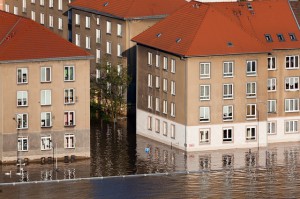With the latest flooding in Burlington, it’s time to think about addressing flood risks and water damage for homes and businesses. Floods are destructive forces that can lead to lasting damages to structures and interior contents. As the last couple months of summer begin to transition into autumn, heavy rains and potential flooding become a possibility across Canada.
Preparing your home or business for high waters is an ongoing endeavor, but also one that takes on urgency when the rains arrive and rivers and streams rise. The most important thing to do is have plans in place to begin protecting your home from flood waters immediately. This requires a good deal of pre-planning, as well as an awareness about the weather forecasts. Here are a few tips to help you begin preparing for flooding.
Elevate Appliances
If a flood alert is issued, elevating appliances and relocating electronics and other valuables is important to protect these items. Keeping flood waters out of the house is the highest priority, but preparing the interior is equally as important. Elevating appliances is a good first step if flood waters are possible. Cinder blocks are good for getting appliances off the floor. Raise appliances at least 30 cm (12 in) off the floor to reduce the risk of water damage. This is often a last minute response, but you should have the materials on hand and be prepared to do this if water levels rise.
Relocate Furniture & Electronics
Relocating other valuables like furniture and electronics is another essential precautionary measure to take if flooding occurs. Heavy rains may cause water levels to rise quickly and, you may not have time to get valuables relocated quickly. If a flood alert is issued, be sure to take the initiative and begin getting furniture elevated, covered, or relocated. All electronics should be moved to higher ground. If you have a basement, relocate all valuables to a higher level.
Seal Openings & Install Flood Gates
Make sure that all cracks and openings around the structure are sealed. This is not a last minute step. You should inspect the foundation and walls and seal any openings where water could infiltrate. Make sure weatherstripping is installed and that doors and windows are well insulated. Keeping water out of the home is always the first priority when waters rise. If you desire, installing portable flood gates around certain parts of your home can be a good way to prevent the infiltration of water. If nothing else, consider sandbagging the perimeter to block out water.




Comments are closed here.